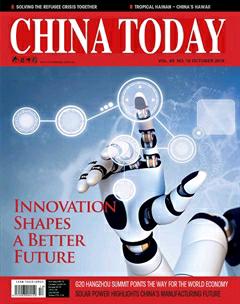Tianjin,Thriving City of Rivers
Tianjin,Thriving City of Rivers
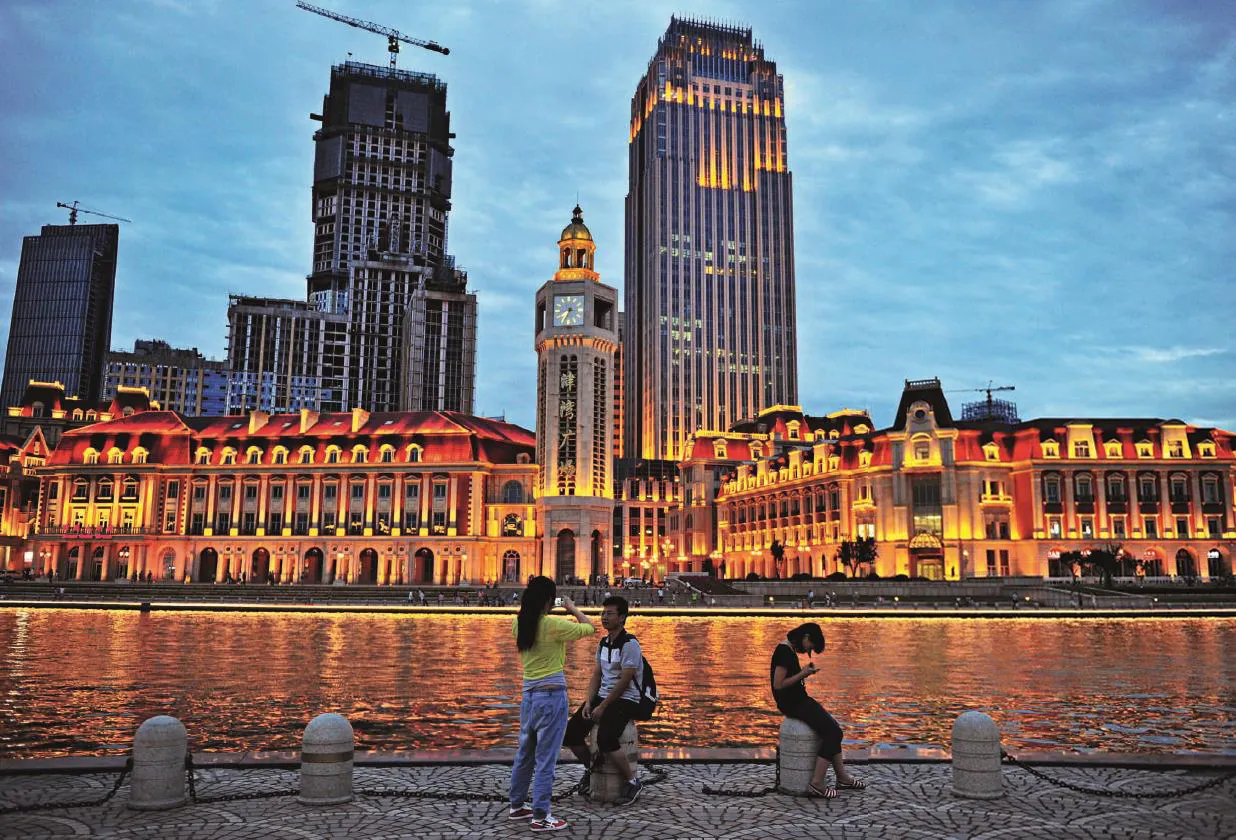
People enjoy the Haihe River scenery.
TIANJIN is one of China’s four municipalities directly under the jurisdiction of the central government. Located to the east of Beijing, it faces the Bohai Sea and is an international shipping hub at the economic center of the Bohai Rim. China (Tianjin) Pilot Free Trade Zone serves the whole of North China.
Tianjin’s Dagu Port is at the mouth of the Haihe River, North China’s largest water system, and upstream its five tributaries - the North Grand Canal,Yongding River, Daqing River, Ziya River, and the South Grand Canal - branch off. Tianjin’s downtown area is located along the lower reaches of the Haihe River.
Tianjin is a city of distinct characteristics, most evident in the personality traits of its residents who imbue the rugged simplicity and innate passion of China’s Northern culture. However, Tianjin also has the capacity for inclusiveness. The First Opium War of 1840-1842 forced the city to open to the outside world. This made it a center for cultural communications between China and the West, and a window for China to learn about Western culture. The resultant collision and blending of traditional culture with that of the West molded Tianjin’s diverse milieu.
Tianjin’s iocation, whereby both river and sea shipments couid be convenientiy transferred to the capitai Beijing,made it a shipping hub for tribute grains.
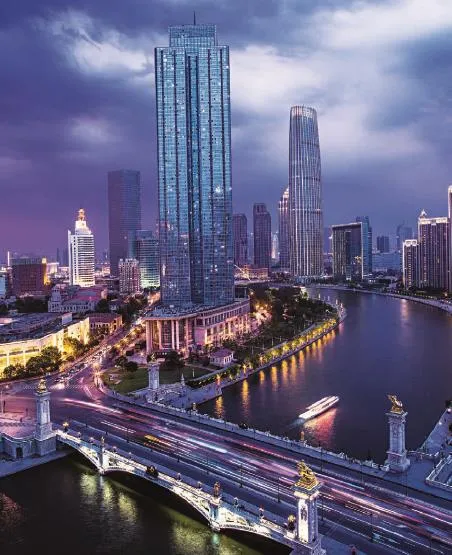
A night view of the Haihe River in Tianjin.
City Born of Rivers
The Grand Canal, built in the seventh century,has long been an important water route connecting Beijing and Hangzhou. It was integral to economic and cultural development and exchanges between China’s north and south.
The section from Shandong’s Linqing City to Tianjin’s Sancha River Estuary, where the South and North Grand Canal and Haihe River converge,is known as the South Grand Canal. That running from Beijing’s eastern suburb of Tongzhou to the estuary, Tianjin’s cradle, meanwhile, is referred to as the North Grand Canal. Way back in the seventh century, China’s central government set up an administration agency here. By the 13th century, the estuary had become a transit center for shipments of tribute grains. It included a special regulatory agency for supervision of salt production and sales.
In 1400, the Prince of Yan, Zhu Di (1360-1424),who later became third emperor of the Ming Dynasty (1368-1644), crossed the Grand Canal at the estuary to journey south and fight for the throne. To commemorate this war, on December 23, 1404, Zhu Di officially named the site Tianjin, which means“Emperor’s ferry crossing.” Owing to Tianjin’s strategic military location, a fortress and barracks were built here and troops installed. This gave rise to the name Tianjinwei (wei means a military establishment), and the starting point of Tianjin’s development.
China’s southern and northern areas were unified once more after the 15th century. Tianjin’s location, whereby both river and sea shipments could be conveniently transferred to the capital Beijing,made it a shipping hub for tribute grains. Before long it became the home of motley groups of boatmen, merchants, soldiers, farmers, and workers.
Dazzling Array of Bridges
Tianjin is the point of convergence of the HaiheRiver tributaries. The Haihe River flows through its downtown area and eventually empties into the sea. These waterways have prompted the building of around 100 bridges in Tianjin of different shapes and styles. They delineate Tianjin’s unique landscape, endowing the city with a distinct bridge culture.
Pontoon bridges were the first to appear in Tianjin. In earlier times their ceaseless flow of traffic was a constant city spectacle. The city’s pontoon bridges, ubiquitous waterways, military fortress,and governmental agencies responsible for salt and taxation management were indeed Tianjin’s main landmarks.
Tianjin moved into the fast modernization lane in the late 19th century, forced as it was to open to the outside world, and driven by China’s Westernization Movement. It was then that construction of a host of bridges in succession took place. In 1887,Dahongqiao, the city’s first steel-structure bridge,appeared. It has since been a main landmark, its name given to Tianjin’s Hongqiao District. The year 1888 saw completion of Jinhua Bridge, the city’s first movable cantilever bridge and China’s first movable steel-structure bridge, across the South Grand Canal. Based on the original pontoon bridges, the steel-structure electricity-driven movable Jintang Bridge was completed in 1906. Another movable cantilever construction, the Magbridge nearby Laolongtou Railway Station (now Tianjin Station), which served the city’s concessions, was completed in 1926. After several renovations, it was renamed Liberation Bridge.
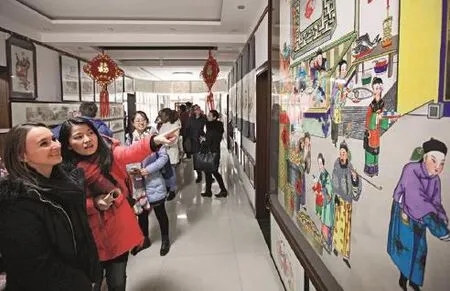
Students from Massachusetts lnstitute of Technology learn about the history and production process of Yangliuqing New Year woodblock paintings on January 14, 2016.
At the turn of the millennium, Tianjin Municipal Government embarked on a comprehensive project to develop the Haihe River. This entailed much renovation and upgrading, which the city accomplished by inviting several prestigious international companies to design and build a host of distinctive bridges. Consequently, a bridge can be spotted every 0.68 km or so within the city boundaries of the upper Haihe reaches. Their blend of distinct local flavor and traditional cultural elements has made them important cultural symbols of the city. As traffic conditions have greatly improved, scenery along the Haihe River has also been upgraded. These distinctive bridges are Tianjin’s most popular tourist attractions.
Bridges across the Haihe River
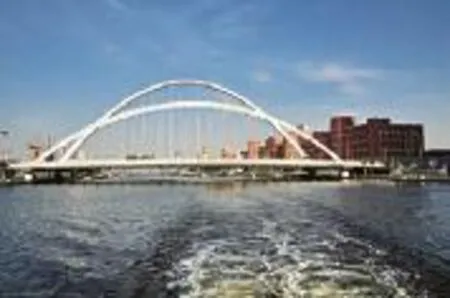
Dagu Bridge: Designed by world-renowned bridge expert and academician of the Chinese Academy of Engineering Deng Wenzhong, Dagu Bridge spans the Haihe River and connects Tianjin’s Hebei and Heping districts. Composed of two asymmetric arches,the bigger one symbolizing the sun and the smaller one the moon, it is 243 m. long and 32 m. wide. This dynamic asymmetrical design of steel box-tied arches obviates the need for piers below the bridge. The first of its kind worldwide, this structure represents a major bridge engineering achievement.

Chifeng Bridge: Located in the central business district of Tianjin’s downtown area across the Haihe River, Chifeng Bridge is China’s only inclined pylon double plane harp cable-stayed bridge. It entailed the largest investment of all bridges across the Haihe. The tower of its major bridge stands 64 m. tall, resembling a sail, and the tower’s foundation is boatshaped. Seen from afar, the bridge as a whole resembles a huge ship sailing on the Haihe River. It is a magnificent spectacle.
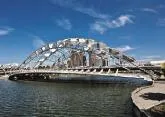
Zhigu Bridge: Originally named Fenghua Bridge, Zhigu is the first mid-height-deck all-steel structured arch bridge. It is 257 m. long,and built from a total 7,066 tons of steel. A distinct and elegant configuration, the bridge consists of three arches which appear as petals floating on the Haihe River. Its distinct, hi-tech design also rendered it one of the world’s most difficult constructions.
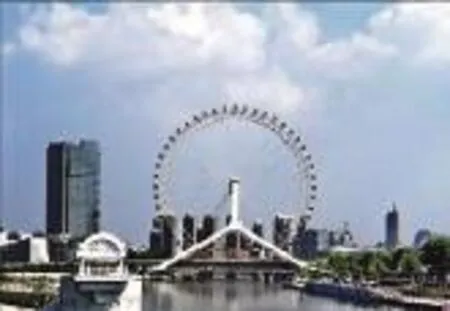
Yongle Bridge: Located on the Sancha River estuary and originally called Cihai Bridge, Yongle Bridge connects the city’s Hebei and Hongqiao districts. The most impressive design feature of this 330m-long structure is the 110 m diameter sky wheel erected on it. To make it even more visually striking, it is painted in the two traditionally Chinesefavored colors of green and red. As night falls, neon lighting illuminates the huge wheel along with the entire bridge, creating a glittering night view of the Haihe River.
Yangliuqing New Year Paintings
Tianjin, although a city nurtured by rivers, is generally regarded as having been born of the Grand Canal, to which its development owes a good deal. Running 190 km within Tianjin, the Grand Canal has left the city multitudinous tangible heritage,including the river course, locks, bridges, dykes,and other ancient remains. It is also site of ancient government offices, shops, towns, villages, streets,guildhalls, and posthouses that formerly flourished along the canal.
Yangliuqing Town is a half-hour drive from Tianjin’s downtown. More than 1,000 years of history have endowed it with a myriad of cultural traditions, and shaped its thriving businesses. The town is also a distribution center for North China’s folk art works. Exceeding in popularity all of China’s New Year woodblock print brands, Yangliuqing New Year paintings enjoy a high reputation. Yangliuqing-crafted kites, papercuts, carved stones and bricks are also in great demand. The town has consequently been awarded the title of “renowned town for inheriting charming Chinese culture.”
Yangliuqing’s two oldest New Year painting shops are those of Dai Lianzeng and Qi Jianlong,whose ancestors were probably also painters. Both came to Yangliuqing to ply their painting skills and avoid the ravages of war. The town’s plentiful birchleaf pear trees and date trees are eminently suitable for making the woodblocks used to produce New Year paintings. This is why New Year painting took root here. The Grand Canal also conveyed fine paper and watercolor pigments to Yangliuqing, so promoting development of local painting. By the Ming (1368-1644) and Qing (1644-1911) dynasties,the local painting industry had gained even greater momentum, and a fine reputation in North China. The mid-to-late Qing Dynasty saw the heyday of Yangliuqing’s New Year painting industry. Back then, residents of both the town and nearby villages were generally solely engaged in producing New Year paintings, making Yangliuqing even more popular.
Featuring a vivid and lively style, abundant colors, and boisterous scenes, Yangliuqing New Year paintings cover a wide range of themes, in particular those reflecting real life, local traditions, and historical stories. One representative work is Liannian Youyu, which portrays a chubby little boy embracing a carp while holding a lotus, so implying lifelong abundance. Its auspicious meaning has made this painting a classic in the genre, and that most widely favored at Lunar New Year.

